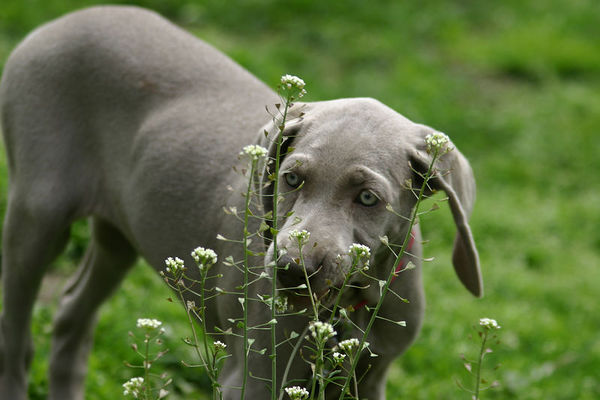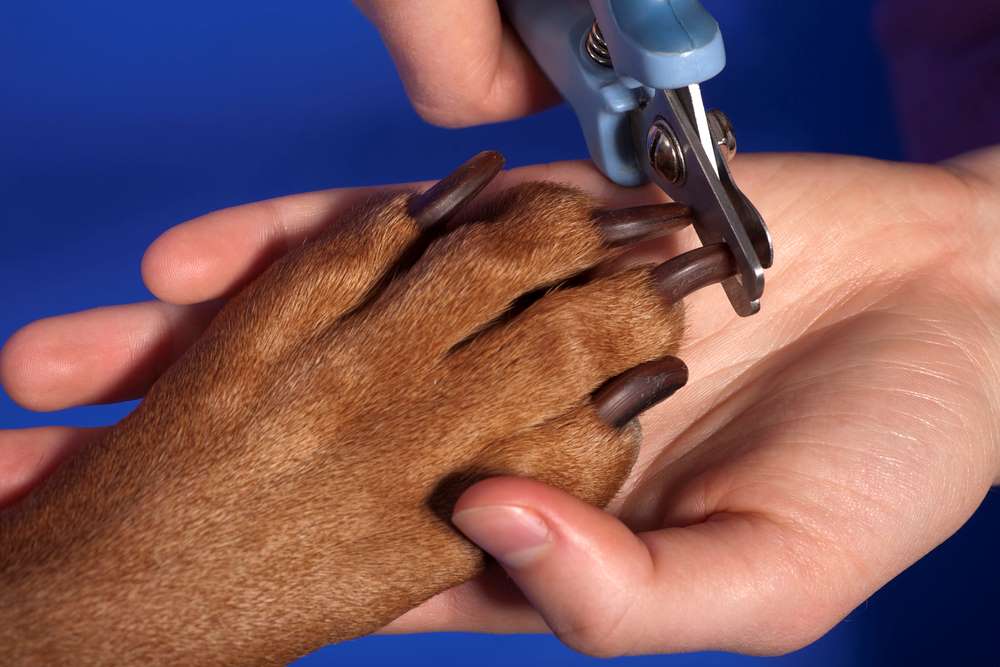Canine seasonal allergies are just what they sound like. They come and go with the seasons, just like your hay fever allergy to pollen and weeds. If your dog has seasonal allergies, you probably won’t notice that he has them, until he is between 6 months and 3 years old.
The allergens (the particles that your dog is allergic to) enter your pet’s body through his nose or respiratory tract. Or sometimes allergens enter through her mouth or gastrointestinal tract, when she breathes or eats.
What are Seasonal Dog Allergies?
Just like with people, we do see hay fever in dogs. It is seasonal or temporary, lasting only for the time that the plants are shedding pollen.
For example, if your dog is allergic to locust tree pollen, he will have symptoms while the locust trees are in blossom. If he is allergic to newly cut grass, he will experience allergic symptoms during the growing season for grass, especially when you mow your lawn.

The most common seasonal allergens for dogs are grass and weeds. If your dog is allergic to grass and weeds, he will show allergy symptoms every year at the same time. And his symptoms will disappear every year at about the same time, usually in fall or winter, when the plants die back or become dormant.
However, it does get a little tricky, because your dog could also be allergic to airborne pathogens like molds or dust. And those allergens are in your home, year round.
Good Dog Breeding Helps
While it is true that fewer than 10% of dogs are genetically predisposed to have seasonal allergies, if your dog is one of them, it is important to you and your dog.
To minimize seasonal dog allergies as much as possible, you should seriously consider purchasing a Weimaraner puppy from one of the many responsible, reputable Weimaraner breeders.
These breeders are focused on improving the standard for the breed, and one of the major standards they consider before breeding a dog, is health and predisposition to diseases.
A Weinheimer with severe or even moderate allergies won’t be bred, thus eliminating that weakness from the gene pool.
However, even with responsible breeding, some Weimaraners just seem to be susceptible to canine allergies.
Seasonal Dog Allergies Symptoms
So what are the symptoms that you might see if your dog has seasonal allergies?
Scratching
Your dog will scratch all over her body, but most often the face, ears, front legs and abdomen. Of course you need to examine your dog to see if she has fleas or a rash. But, if she is scratching, something is not right.
Sneezing
Yes, dogs do sneeze. This is one symptom that you will probably notice. Especially if your dog’s sneezing is in the spring or fall, when there is a lot of pollen in the air.
Eye discharges
Pollen or mold sensitivity often cause some eye and/or nose discharge in your dog. You’ll probably notice the discharge in the corner of your dog’s eyes, and on the fur beneath them.
This is not nearly as bad as it is for a person with hay fever.
Face Rubbing
You may also find some sores on your dog’s face and front legs. Most of the little sores that you will see are caused by your dog’s scratching and biting himself.
If your dog is rubbing his face against the sofa, your legs and other objects, look a little closer to see if you can tell what is bothering him.
Foot Licking and Chewing
An allergic pet with atopic dermatitis, or dog seasonal allergies, will often lick her paws and rub her face with her paws. You may even notice that your dog’s paws always seem to be wet.
Redness
A dog with allergies can have redness anywhere, but the most common place is in the armpits and groin area. This is caused by scratching and biting.
Asthma-like Symptoms
Rarely, we see a dog with asthma. When this does occur, the symptoms are similar to those in people, including wheezing and difficulty breathing.
Your dog’s saliva keeps her eyes and face moist when she has allergies. And, over time, the hair around the eyes and on the paws on light colored dogs, will turn a rust or pink color from the moist saliva. A good example of this is the little white Bichon Frise dog.
When your dog is itching and scratching, it is important for you to help relieve the irritation. Redness and swelling can lead to open wounds, scabbing, infection, and hair loss if your dog keeps scratching and biting.
Make sure you write down when you first notice the symptoms and when they disappear. With dog seasonal allergies, timing is everything.
Relief for Canine Seasonal Allergies
If you suspect that your Weimaraner has seasonal dog allergies, you can take these steps to relieve him:
Bathe your Weimaraner
About once a month, give your dog a bath, during the off season months. Remember to rinse very thoroughly several times.
During the pollen season, bathing your dog more frequently will help wash the allergens away. Use a high quality hypoallergenic dog shampoo like HYLYT hypoallergenic shampoo to soothe and heal the irritated areas.
Brush your Weimaraner
Especially during pollen season, brush you dog daily. This is most important after a romp outdoors or a day in the woods or fields. Brushing your dog helps remove pollen and weed seeds.
Vacuum your Carpet Frequently
If you regularly vacuum your rugs with a HEPA Filter Vacuum Cleaner, you can filter out many of the allergens that are causing your dog’s problems.
Steam Clean
Steam cleaning is another way to remove allergens from your carpets and floors. With a home steam cleaner, you can get rid of mold and dust mites. Make sure you use the cleaner to get into corners and cracks and don’t forget to steam clean the places where your dog sleeps.
Close the Windows
Keep the windows in your home closed, especially during the Spring and Fall months. If you have air conditioning, that helps filter out pollen and other allergens.
Many of the seasonal allergens come in through the windows.
Tru Dog Complete Me
This is a soft dog chew supplement that ensures that your dog gets all the nutrients that he needs. It strengthens your dog’s immune system and also fights inflammation, which is part of an allergic reaction.
Spray your Dog
Spray your dog’s itchy spots. Use a natural spray like Dermabliss Anti-itch Spray. It’s made from oat extract, which is both soothing to itchy areas and moisturizing.
If you take these steps and your Weimaraner is still suffering from severe dog allergies, you may need to consult with your vet.
While dog seasonal allergies certainly are a nuisance and can be very uncomfortable for your dog, they are not life threatening.
Using natural products for seasonal canine allergies may help your pet to be more comfortable, without side effects, during the “allergic months”.






Leave a Reply